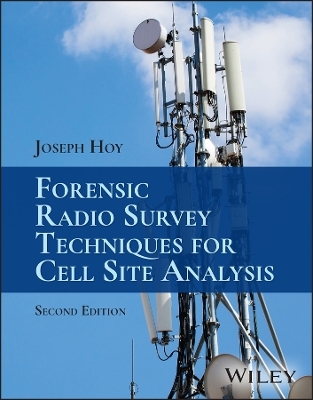
Forensic Radio Survey Techniques for Cell Site Analysis
John Wiley & Sons Inc (Verlag)
978-1-394-19717-0 (ISBN)
The newly updated and revised Second Edition of Forensic Radio Survey Techniques for Cell Site Analysis provides an overview of the end-to-end process of planning, undertaking, and reporting of forensic radio surveying to support the forensic discipline of cell site analysis. It starts by recapping and explaining, in an accessible way, the theory, structure, and operation of cellular communications networks, then moves on to describe the techniques and devices employed to undertake forensic radio surveys.
Worked examples are used throughout to demonstrate the practical steps required to plan and undertake forensic radio surveys, including the methods used to analyze radio survey data and compile it into a court report. A summary section condenses the technical and practical elements of the book into a handy reference resource for busy practitioners.
The Second Edition contains 25% brand new material covering 5G New Radio networks and ‘6G and beyond,’ critical communications, mobile satellite communications, IoT networks, Cell Site Analysis Tools, and much more.
Other sample topics covered in Forensic Radio Survey Techniques for Cell Site Analysis include:
Radio theory, covering RF propagation, basic terminology, propagation modes, multipath transmission, and carrying information on a radio signal
Core networks, including 2G, 3G, 4G, and 5G, subscriber and device identifiers, and international and temporary mobile subscriber identities
Cell access control, covering cell barring, forbidden LAC/TAC, location updating, inter- and intra-carrier handovers, and 3GPP network types
Forensic radio surveys objectives, terminology, and types, along with location, static spot, and indoor surveys
The Second Edition of Forensic Radio Survey Techniques for Cell Site Analysis is an essential reference on the subject for police analysts, practitioners, technicians, investigators, and cell site experts, along with legal professionals and students/trainees in digital forensics.
Joseph Hoy, CPO (Chief Products Officer) & Co-Founder, Forensic Analytics Ltd, UK. Joseph Hoy is a telecoms engineer and trainer with over 30 years of industry experience. His company are digital forensic experts, combining innovative analytics software with vast sector expertise to assist government agencies and law enforcement via accredited training courses, Cell Site Analysis, RF surveying and Cellular technologies, expert witness services, and on-site consulting
About the Author xvii
Preface xix
Acknowledgements xxi
Acknowledgements for the 2nd Edition xxiii
Glossary xxv
1 Forensic Radio Surveys for Cell Site Analysis 1
1.1 Cell Site Analysis 1
1.2 Forensic Radio Surveying 1
2 Radio Theory 3
2.1 RF Propagation 3
2.2 Carrying Information on a Radio Signal 8
2.3 Radio Spectrum 10
2.4 RF Measurements 14
3 Wireless Technologies and Deployments 21
3.1 Coordinating Cellular Development 21
3.2 Evolution from 0G to 5G 21
3.3 3GPP Network Types 25
3.4 3GPP2 Network Types 26
3.5 Other Types of Network 26
3.6 Deployed Technologies by Region 29
3.7 Commonly Used Frequency Bands by Region 30
4 Cellular Theory 33
4.1 Pre-cellular Radiotelephone Networks 33
4.2 Radio Cells 33
4.3 Frequency Reuse 35
4.4 Cell Size and Coverage 36
4.5 Duplex Techniques 37
4.6 Multiple Access Techniques 38
4.7 Generic Network Architecture 41
4.8 Mobile Devices and SIMs 41
4.9 Radio Access Networks 43
4.10 Core Networks 50
4.11 Subscriber and Device Identifiers 55
4.12 Network Databases 59
4.13 Cell Sites 61
4.14 Antennas and Azimuths 66
4.15 Uptilt and Downtilt 68
4.16 Cell Types and Sizes 69
4.17 Cell Site Types and Uses 70
4.18 Single and Multi-frequency Networks 70
4.19 Cell Coverage Concepts 73
4.20 Small Cells and Closed Subscriber Groups 75
4.21 Network Activities 76
4.22 Idle Mode and Connected Mode 80
4.23 Cell Access Control 85
4.24 Location Updating (Idle Mode Mobility) 87
4.25 Handover (Connected Mode Mobility) 88
4.26 Network Sharing 89
5 3GPP Network Types 91
5.1 2G GSM Networks 91
5.2 3G UMTS/HSPA Networks 103
5.3 4G LTE Networks 118
5.4 5G NR Networks 135
6 Other Cellular Network Types 157
6.1 2G IS-95/cdmaOne 157
6.2 3G IS-2000/CDMA2000 1x RTT 158
6.3 3G CDMA2000 EV-DO 166
6.4 Surveying Other Technologies 168
6.5 Global Navigation Satellite Systems 188
7 Forensic Radio Surveys 191
7.1 Forensic Radio Survey Objectives 191
7.2 Forensic Radio Survey Terminology 191
7.3 Forensic Radio Survey Types and Techniques 192
7.4 Idle Mode versus Connected Mode Surveys 201
7.5 Additional Survey Techniques 208
7.6 Survey Preparation 213
7.7 Typical Survey Actions and Procedures 216
7.8 Survey Results: Checking and Confirmation 226
7.9 Survey Notes and Progress Maps 228
7.10 Survey Equipment Types 228
7.11 Raw Survey Results 233
7.12 Processing Survey Results 239
7.13 Understanding Survey Results 245
7.14 Storage of Survey Data 248
7.15 Quality and Best Practice 250
7.16 Summary of Typical Survey Results 254
8 Cell Site Analysis 259
8.1 Cell Site Concepts 259
8.2 Uses and Limitations of Cell Site Evidence 260
8.3 Regulation of Cell Site Analysis 267
8.4 Components of Cell Site Analysis 271
8.5 Call Detail Records 271
8.6 Sources of Cellular Coverage Data 283
8.7 Forensic Radio Surveys 284
8.8 Cell Site Reports 286
8.9 Call Schedules 291
8.10 Maps and Graphics 292
8.11 Report Checking and Peer Review 295
8.12 Professional and Expert Witnesses 295
8.13 Court Presentations 297
8.14 Support for 'Live' Investigations 300
8.15 Cell Site Analysis and Forensic RF Surveys 308
9 Summary and Practical Activities 311
9.1 Radio and Cellular Concepts 311
9.2 Cellular Identifiers 314
9.3 Cellular Network Types 321
9.4 Forensic Radio Surveys 329
9.5 Survey Results: Checking and Confirmation 336
9.6 Survey Notes and Progress Maps 337
9.7 Survey Results 337
9.8 Cell Site Analysis 343
9.9 End-to-End Process 346
9.10 Overall List of Events/Locations 347
9.11 Source Files Attribution List 348
9.12 Normalise Call Data into a Standard Format 348
9.13 Create an Overall Cell List 352
9.14 Creating a Case Overview Map 352
9.15 Compile Radio Survey Summary Tables 353
9.16 Creating Call and Cell Labels 358
9.17 Cell Site Mapping Presentations 359
9.18 Summary 362
9.19 Further Reading 362
References 363
Index 365
| Erscheinungsdatum | 16.01.2024 |
|---|---|
| Verlagsort | New York |
| Sprache | englisch |
| Maße | 225 x 281 mm |
| Gewicht | 1247 g |
| Themenwelt | Recht / Steuern ► EU / Internationales Recht |
| Recht / Steuern ► Strafrecht ► Kriminologie | |
| Technik ► Elektrotechnik / Energietechnik | |
| Technik ► Nachrichtentechnik | |
| ISBN-10 | 1-394-19717-9 / 1394197179 |
| ISBN-13 | 978-1-394-19717-0 / 9781394197170 |
| Zustand | Neuware |
| Informationen gemäß Produktsicherheitsverordnung (GPSR) | |
| Haben Sie eine Frage zum Produkt? |
aus dem Bereich


